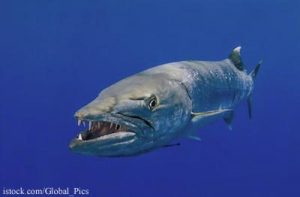Fish and marine toxins are the food/pathogen combination responsible for the most food poisoning outbreaks, according to a new study by the Centers for Disease Control and Prevention (CDC). Fish contaminated with scombroid toxin and ciguatera took the top two spots on the study’s list of the most pathogen /commodity pairings that caused the most outbreaks, beating out Salmonella on poultry, norovirus on leafy greens.
 Although the fish/marine toxin combo took the top two spots on the pathogen /commodity pairings that caused the most outbreaks, they didn’t rank at all in terms of the pairing that caused the most illnesses (norovirus and leafy vegetables), hospitalizations (Salmonella and fruits/nuts) or deaths (Listeria and poultry.) So what are these marine toxins and what happens to you when you ingest them?
Although the fish/marine toxin combo took the top two spots on the pathogen /commodity pairings that caused the most outbreaks, they didn’t rank at all in terms of the pairing that caused the most illnesses (norovirus and leafy vegetables), hospitalizations (Salmonella and fruits/nuts) or deaths (Listeria and poultry.) So what are these marine toxins and what happens to you when you ingest them?
Scombroid toxin or histamine fish poisoning is caused when certain kinds of fish including tuna, mackerel and bonito, are not promptly and continuously refrigerated. When these fish are not properly refrigerated, bacteria break down the fish protein and produce histamines as a byproduct. There isn’t any physical evidence of the this kind of spoilage, no bad smell, for example, and histamine is heat resistant so it can survive the cooking process.
Eating fish spoiled with scombroid toxin will create illness quickly. Symptoms can begin to appear between two minutes and two hours after eating the fish and include rash, diarrhea, flushing, sweating, headache, and vomiting. Sometimes burning or swelling of the mouth, abdominal pain, or a metallic taste may also occur. For most people the symptoms last a few hours or less.
Ciguatera poisoning is caused by microscopic sea plants called dinoflagellates that appear in tropical reef fish. The bigger the fish, the higher the concentration of these toxins is likely to be. Barracuda are most commonly associated with ciguatoxin poisoning, but illness can also occur eating grouper, sea bass, snapper and mullet.
Like, scombroid poisoning, ciguatoxin will cause symptoms to appear quickly, usually within a few minutes to 30 hours after eating contaminated fish. Symptoms include nausea, vomiting, diarrhea, cramps, excessive sweating, headache, and muscle aches. Burning or “pins-and-needles” sensations, weakness, itching, and dizziness can also occur. Some patients report the reversal of temperature sensation in their mouth , unusual taste sensations, nightmares, or hallucinations. Symptoms can last one to four weeks.




